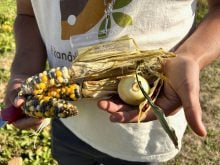Looking back at the recent holistic management conference I attended in south-central Saskatchewan, the word that flits across my mind is “different.”
Such a different group of people. What different farming techniques. These ideas are so different.
While some people around the tables at Assiniboia’s Prince of Wales Cultural and Recreation Centre already knew each other, many other tables were filled with strangers. That unfamiliarity didn’t limit chit-chatting, though. Every break between speakers was met with a rising buzz of conversation, amplifying the number of people in attendance.
Read Also

The new spin on farm legacy
Farmers are starting to think differently about the future of their farms in Western Canada. What does this mean for the next generation and farm succession planing?
It was clear that this wasn’t just a bunch of conference attendees. They were a community. No matter what topic was being discussed throughout the conference, the importance of community was tied in. Many speakers and panellists took time out of their window in the spotlight to mark the positive impact of strong connections on individuals, families, and operations.
I learned that these people consider community and the skills and means to communicate on any manner of ideas essential to the practices of holistic farm management. The discussion of ideas and experiences is critical, with the failures being shared as often as the successes. Nothing is a secret.
Some of the information shared on methods and strategies might be described as various shades of off the wall or, at the very least, a challenge for more conventionally managed farms. At the same time, they were concepts that I could easily wrap my head around and, based on my own personal experience growing up on a small cattle farm, understand the rationale and potential value of.
There was a lot of talk about incorporating cover crops and intercropping into regular rotations to keep the ground and root systems healthy, retain moisture, and — if need be — create a ready-to-go feed mix. There was conversation around grazing strategies and avoiding the overgraze that speakers warned could damage the roots, preventing strong regrowth.
Extended grazing, perhaps unsurprisingly, was another topic — the idea of bale grazing or placing feeders in a pasture rather than the corral to encourage animals to move, something speakers linked to healthier animals, higher conception rates and better distribution of nutrients, whether from what’s cycled through the animal or just what’s left on the ground.
These few examples show the simplicity in basics. These methods also seem like something from the past, when agriculture was on a much smaller scale and a means of feeding only a household.
But why not adapt the long-past traditions to a larger scale? While the system wasn’t perfect and the economic reality those farmers faced was much different than the one farmers do today, there were also benefits for the land and animals, both livestock and wildlife. If we can viably recapture those benefits for the modern farm, why not try to do so?
This has certainly been the experience of a few southern Saskatchewan ranchers, who say that kind of philosophy has helped them deal more effectively with drought.
Canadian agriculture today faces challenges: some economic, some environmental. A little inspiration from the past, blending the holistic approach with more conventional methods, might open doors to out-of-the-box solutions.
















